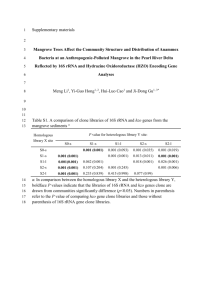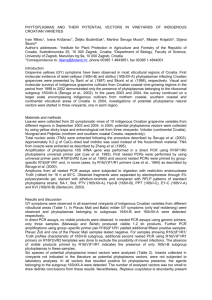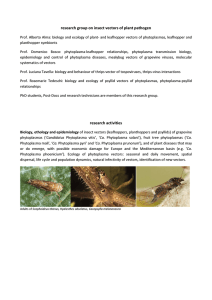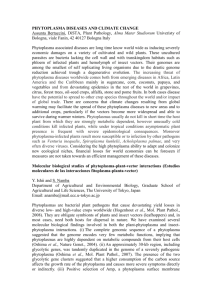Martina Šeruga Musić, Mladen Krajačić, Dijana Škorić
advertisement
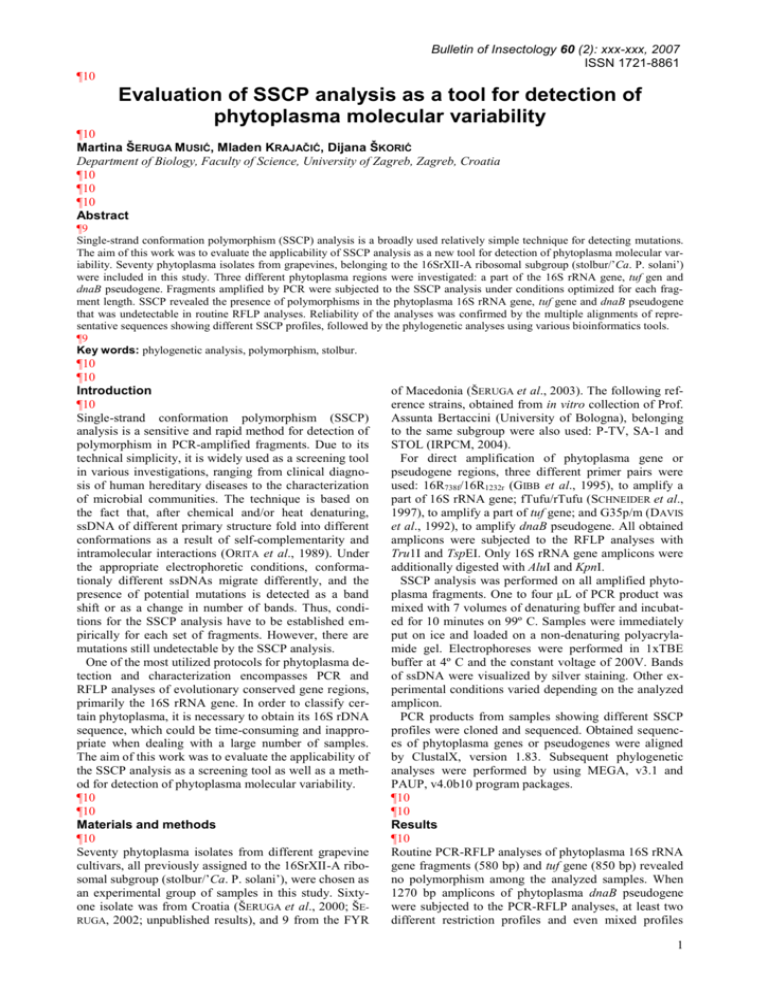
Bulletin of Insectology 60 (2): xxx-xxx, 2007 ISSN 1721-8861 ¶10 Evaluation of SSCP analysis as a tool for detection of phytoplasma molecular variability ¶10 Martina ŠERUGA MUSIĆ, Mladen KRAJAČIĆ, Dijana ŠKORIĆ Department of Biology, Faculty of Science, University of Zagreb, Zagreb, Croatia ¶10 ¶10 ¶10 Abstract ¶9 Single-strand conformation polymorphism (SSCP) analysis is a broadly used relatively simple technique for detecting mutations. The aim of this work was to evaluate the applicability of SSCP analysis as a new tool for detection of phytoplasma molecular variability. Seventy phytoplasma isolates from grapevines, belonging to the 16SrXII-A ribosomal subgroup (stolbur/’Ca. P. solani’) were included in this study. Three different phytoplasma regions were investigated: a part of the 16S rRNA gene, tuf gen and dnaB pseudogene. Fragments amplified by PCR were subjected to the SSCP analysis under conditions optimized for each fragment length. SSCP revealed the presence of polymorphisms in the phytoplasma 16S rRNA gene, tuf gene and dnaB pseudogene that was undetectable in routine RFLP analyses. Reliability of the analyses was confirmed by the multiple alignments of representative sequences showing different SSCP profiles, followed by the phylogenetic analyses using various bioinformatics tools. ¶9 Key words: phylogenetic analysis, polymorphism, stolbur. ¶10 ¶10 Introduction ¶10 Single-strand conformation polymorphism (SSCP) analysis is a sensitive and rapid method for detection of polymorphism in PCR-amplified fragments. Due to its technical simplicity, it is widely used as a screening tool in various investigations, ranging from clinical diagnosis of human hereditary diseases to the characterization of microbial communities. The technique is based on the fact that, after chemical and/or heat denaturing, ssDNA of different primary structure fold into different conformations as a result of self-complementarity and intramolecular interactions (ORITA et al., 1989). Under the appropriate electrophoretic conditions, conformationaly different ssDNAs migrate differently, and the presence of potential mutations is detected as a band shift or as a change in number of bands. Thus, conditions for the SSCP analysis have to be established empirically for each set of fragments. However, there are mutations still undetectable by the SSCP analysis. One of the most utilized protocols for phytoplasma detection and characterization encompasses PCR and RFLP analyses of evolutionary conserved gene regions, primarily the 16S rRNA gene. In order to classify certain phytoplasma, it is necessary to obtain its 16S rDNA sequence, which could be time-consuming and inappropriate when dealing with a large number of samples. The aim of this work was to evaluate the applicability of the SSCP analysis as a screening tool as well as a method for detection of phytoplasma molecular variability. ¶10 ¶10 Materials and methods ¶10 Seventy phytoplasma isolates from different grapevine cultivars, all previously assigned to the 16SrXII-A ribosomal subgroup (stolbur/’Ca. P. solani’), were chosen as an experimental group of samples in this study. Sixtyone isolate was from Croatia (ŠERUGA et al., 2000; ŠERUGA, 2002; unpublished results), and 9 from the FYR of Macedonia (ŠERUGA et al., 2003). The following reference strains, obtained from in vitro collection of Prof. Assunta Bertaccini (University of Bologna), belonging to the same subgroup were also used: P-TV, SA-1 and STOL (IRPCM, 2004). For direct amplification of phytoplasma gene or pseudogene regions, three different primer pairs were used: 16R738f/16R1232r (GIBB et al., 1995), to amplify a part of 16S rRNA gene; fTufu/rTufu (SCHNEIDER et al., 1997), to amplify a part of tuf gene; and G35p/m (DAVIS et al., 1992), to amplify dnaB pseudogene. All obtained amplicons were subjected to the RFLP analyses with Tru1I and TspEI. Only 16S rRNA gene amplicons were additionally digested with AluI and KpnI. SSCP analysis was performed on all amplified phytoplasma fragments. One to four μL of PCR product was mixed with 7 volumes of denaturing buffer and incubated for 10 minutes on 99º C. Samples were immediately put on ice and loaded on a non-denaturing polyacrylamide gel. Electrophoreses were performed in 1xTBE buffer at 4º C and the constant voltage of 200V. Bands of ssDNA were visualized by silver staining. Other experimental conditions varied depending on the analyzed amplicon. PCR products from samples showing different SSCP profiles were cloned and sequenced. Obtained sequences of phytoplasma genes or pseudogenes were aligned by ClustalX, version 1.83. Subsequent phylogenetic analyses were performed by using MEGA, v3.1 and PAUP, v4.0b10 program packages. ¶10 ¶10 Results ¶10 Routine PCR-RFLP analyses of phytoplasma 16S rRNA gene fragments (580 bp) and tuf gene (850 bp) revealed no polymorphism among the analyzed samples. When 1270 bp amplicons of phytoplasma dnaB pseudogene were subjected to the PCR-RFLP analyses, at least two different restriction profiles and even mixed profiles 1 were observed. Because of different fragment length for each set of PCR products amplified with different primers, conditions for SSCP analyses had to be optimized by changing a percentage of acrylamide in a gel, presence of glycerol in a gel and duration of the electrophoresis. For 580 bp fragments, the best results were achieved in 14% polyacrylamide (PA) gels with 5% glycerol that were run for 7-8h, while for longer fragments, it was 8% PA gel with 2.5% glycerol with duration of the electrophoresis of 3-4h. SSCP analyses of the phytoplasma 16S rRNA gene fragment showed several different profiles, even with the presence of multiple ssDNA bands in some of the samples. When amplified fragments of the phytoplasma tuf gene were subjected to SSCP analyses, two different patterns were found with equal frequency among the samples. ¶10 ¶10 Figure 1. SSCP patterns of phytoplasma tuf gene fragments (850) bp, amplified from Croatian grapevine extracts by using primer pair fTufu/rTufu. Analyses were performed in 8% polyacrylamide gels that were silver stained after the electrophoresis. Samples are marked as follows: Im6 - cv. Riesling, Imbriovec; J902 - cv. Chardonnay, Jazbina; J10-02 - cv. Chardonnay, Jazbina; Jsk10 - cv. Chardonnay, Jaska; IL3, IL4 - cv. Chardonnay, Ilok; IL7 - cv. Riesling, Ilok; SA-1 phytoplasma reference strain belonging to the 16SrXII-A ribosomal subgroup (‘Ca. P. solani’). ¶10 ¶10 The results of dnaB pseudogene SSCP analyses revealed the presence of 5 profiles, indicating even more polymorphism in this region than it was shown by the RFLP analyses. Multiple alignments of chosen sequenced fragments showed that the ones having the same SSCP profiles shared identical or nearly identical nucleotide sequences. However, a clear correlation between a specific mutation and the specific SSCP profile could not be established. Phylogenetic analyses of phytoplasma sequences obtained in this study also corroborated the results of the SSCP analyses. Nucleotide sequences of fragments having similar SSCP profiles clustered together on the phylogenetic tree, indicating their close relatedness. ¶10 ¶10 Discussion ¶10 The results of phytoplasma 16S rRNA gene, tuf gene and dnaB pseudogene SSCP analyses revealed the presence of molecular variability among the isolates belonging to the same ribosomal subgroup (stolbur; 16SrXIIA). This polymorphism could not be detected by routine RFLP analyses, indicating the presence of mutations in 2 regions out of the restriction sites. Nonetheless, we observed certain mutations that could not be associated with the change of the profile, which is one of disadvantages of the method. In comparison with RFLP, SSCP still confers many advantages. It is more sensitive, cheaper, less time-consuming and particularly suitable as a fast screening method when dealing with a large number of field samples. Thus, SSCP analysis can also be considered as a tool in a search for phytoplasma molecular variability. ¶10 ¶10 Acknowledgements ¶10 We thank our former undergraduate student Dubravka Pezić for her assistance with the SSCP optimization. ¶10 ¶10 References ¶ DAVIS R.E., PRINCE J.P., HAMMOND R.W., DALLY E.L., LEE I.M., 1992.- Polymerase chain reaction detection of Italian periwinkle virescence mycoplasmalike organisms (MLO) and evidence for relatedness with aster yellows MLOs.- Petria, 2: 183-192. GIBB K.S., PADOVAN A.C., MOGEN B.A., 1995.- Studies on sweet potato little-leaf phytoplasmas detected in sweet potato and other plant species growing in Northern Australia.Phytopathology, 85: 169-174. IRPCM PHYTOPLASMA/SPIROPLASMA WORKING TEAM– PHYTOPLASMA TAXONOMY GROUP, 2004.- ‘Candidatus Phytoplasma’, a taxon for the wall-less, non-helical prokaryotes that colonize plant phloem and insects.International Journal of Systematic and Evolutionary Microbiology, 54: 1243-1255. ORITA M., IWAHANA H., KANAZAWA H., HAYASHI K., SEKIYA T., 1989.- Detection of polymorphism of human DNA by gel electrophoresis as single-strand conformation polymorphisms.- Proceedings of the National Academy of Sciences, 86: 2766-2770. SCHNEIDER B., GIBB K.S., SEEMÜLLER E., 1997.- Sequence and RFLP analysis of the elongation factor Tu gene used in differentiation and classification of phytoplasmas.- Microbiology, 143: 3381-3389. ŠERUGA M., ĆURKOVIĆ PERICA M., ŠKORIĆ D., KOZINA B., MIROŠEVIĆ N., ŠARIĆ A., BERTACCINI A., KRAJAČIĆ M., 2000.- Geographic distribution of Bois Noir phytoplasmas infecting grapevines in Croatia.- Journal of Phytopathology, 148 (4): 239-242. ŠERUGA M., 2002.- Molecular detection and identification of phytoplasmas in Croatian grapevines (Vitis vinifera L.).Master of Science Thesis, University of Zagreb. ŠERUGA M., ŠKORIĆ D., KOZINA B., MITREV S., KRAJAČIĆ M., ĆURKOVIĆ PERICA M., 2003.- Molecular identification of a phytoplasma infecting grapevine in the Republic of Macedonia.- Vitis, 42 (4): 181-184. ¶ Corresponding author: Martina ŠERUGA MUSIĆ, (martina@botanic.hr), Department of Biology, Faculty of Science, University of Zagreb, Marulićev trg 9A, HR-10000 Zagreb, Croatia.



